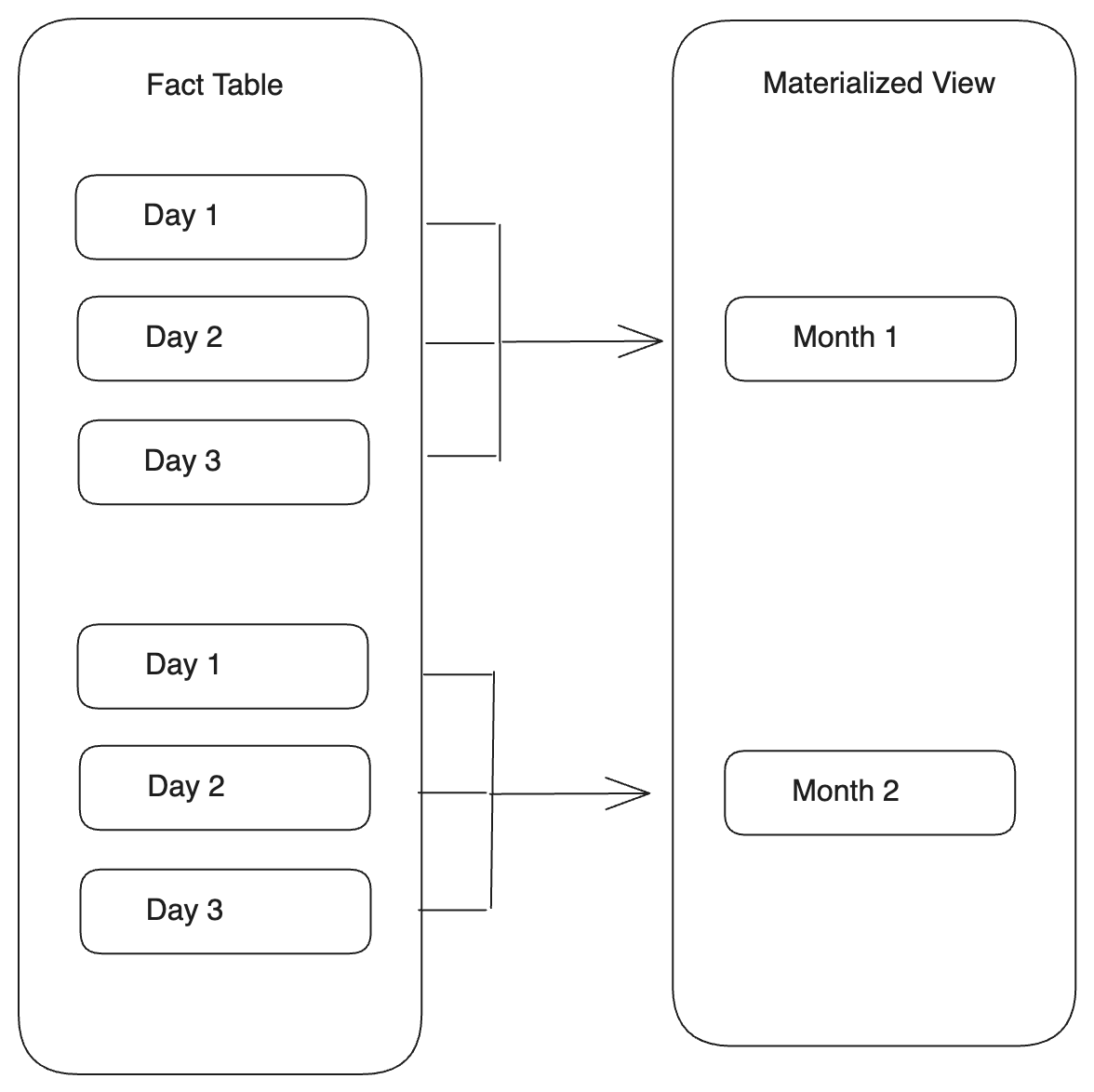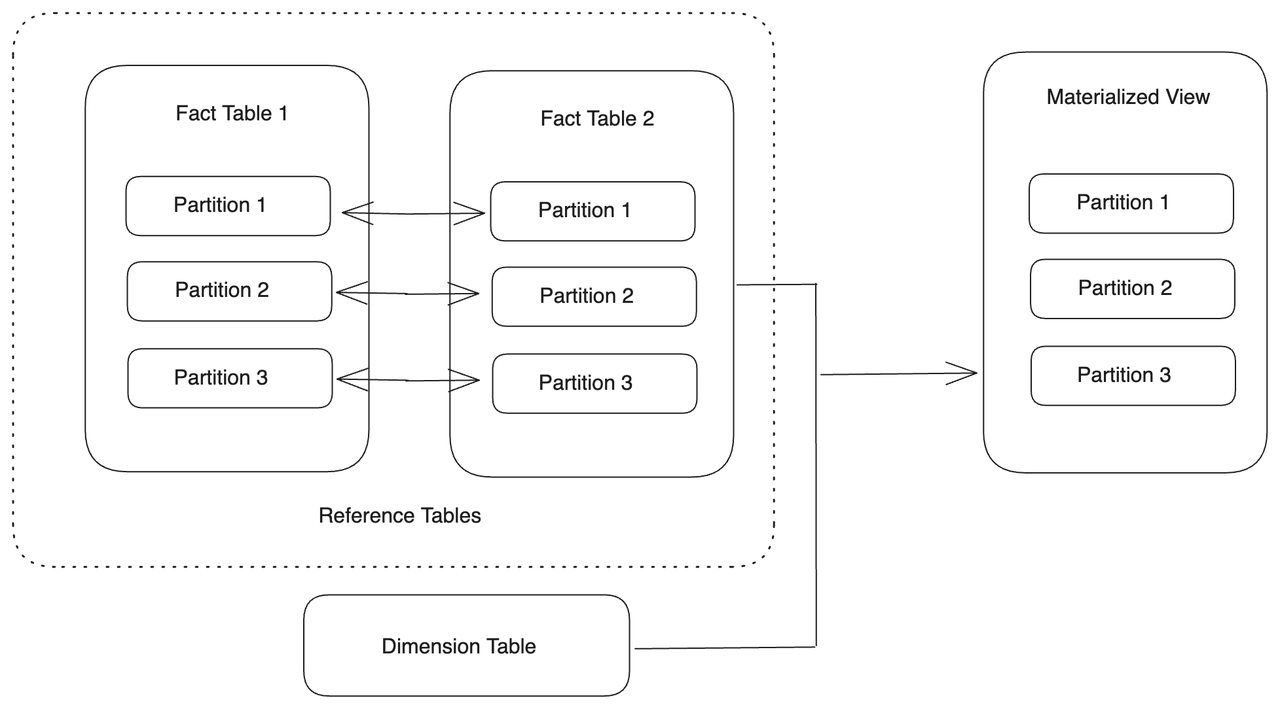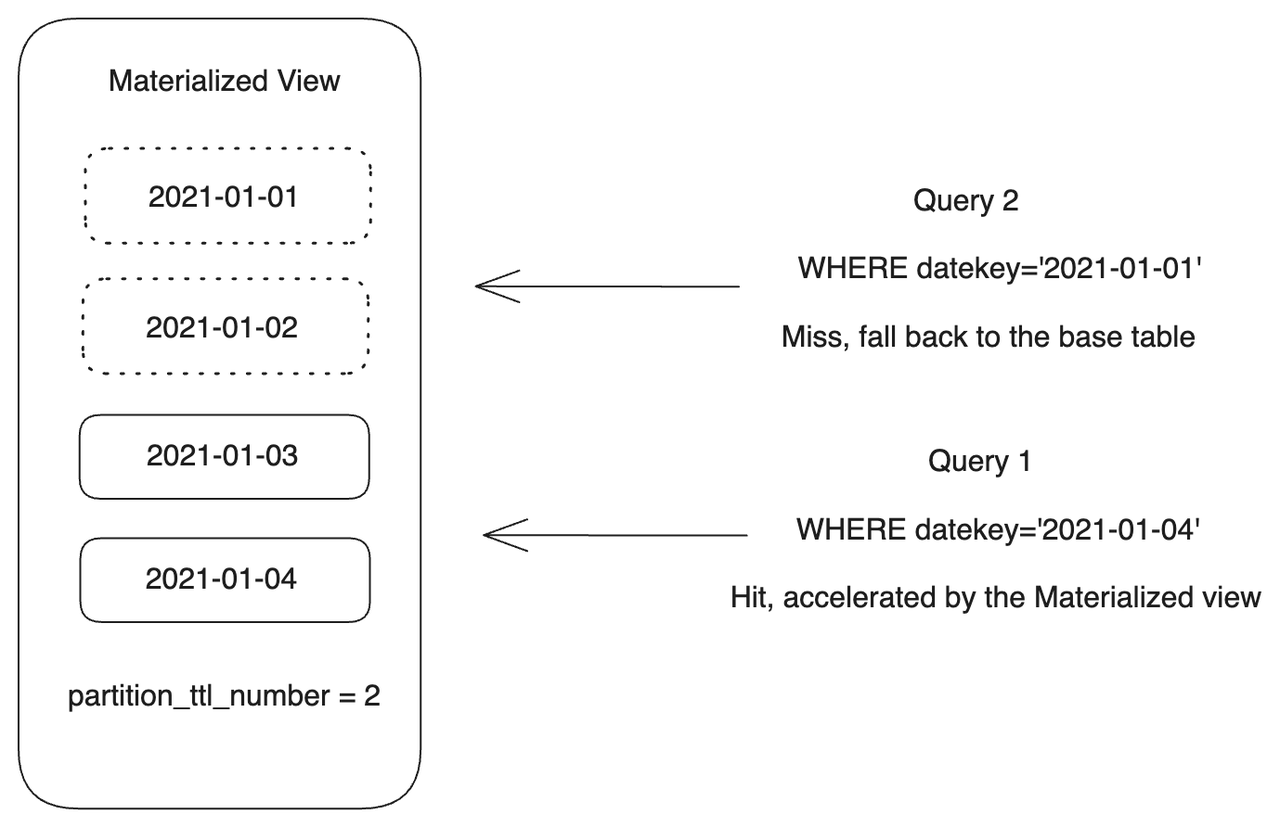Create a partitioned materialized view
This topic introduces how to create a partitioned materialized view to accommodate different use cases.
Overview
StarRocks' asynchronous materialized views support a variety of partitioning strategies and functions that allow you to achieve the following effects:
-
Incremental construction
When creating a partitioned materialized view, you can set the creation task to refresh partitions in batches to avoid excessive resource consumption.
-
Incremental refresh
You can set the refresh task to update only the corresponding partitions of the materialized view when it detects data changes in certain partitions of the base table. Partition-level refresh can significantly prevent the waste of resources used to refresh the entire materialized view.
-
Partial materialization
You can set TTL for materialized view partitions, allowing for partial materialization of the data.
-
Transparent query rewrite
Queries can be rewritten transparently based on only those updated materialized view partitions. Partitions that are deemed outdated will not be involved in the query plan, and the query will be executed on the base tables to guarantee the consistency of data.
Limitations
A partitioned materialized view can be created only on a partitioned base table (usually a fact table). Only by mapping the partition relationship between the base table and the materialized view can you build the synergy between them.
Currently, StarRocks supports building partitioned materialized views on tables from the following data sources:
- StarRocks OLAP tables in the default catalog
- Supported partitioning strategy: Range partitioning, List Partitioning, and Expression Partitioning
- Supported data types for Partitioning Key: INT, DATE, DATETIME, and STRING
- Supported table types: Primary Key, Duplicate Key, Aggregate Key, and Unique Key
- Supported both in shared-nothing cluster and shared-data cluster
- Tables in Hive Catalog, Hudi Catalog, Iceberg Catalog, and Paimon Catalog
- Supported partitioning level: Primary level
- Supported data types for Partitioning Key: INT, DATE, DATETIME, and STRING
- You cannot create a partitioned materialized view based on a non-partitioned base (fact) table.
- For StarRocks OLAP tables, the two adjacent partitions of the base table must have consecutive ranges.
- For multi-level partitioned base tables in external catalogs, only the primary level partitioning path can be used to create a partitioned materialized view. For example, for a table partitioned in the
yyyyMMdd/hourformat, you can only build the materialized view partitioned byyyyyMMdd. - From v3.2.3, StarRocks supports creating partitioned materialized views upon Iceberg tables with Partition Transforms, and the materialized views are partitioned by the column after the transformation. For more information, see Data lake query acceleration with materialized views - Choose a suitable refresh strategy.
Use cases
Suppose there are base tables as follows:
CREATE TABLE IF NOT EXISTS par_tbl1 (
datekey DATE, -- DATE type date column used as the Partitioning Key.
k1 STRING,
v1 INT,
v2 INT
)
ENGINE=olap
PARTITION BY RANGE (datekey) (
START ("2021-01-01") END ("2021-01-04") EVERY (INTERVAL 1 DAY)
)
DISTRIBUTED BY HASH(k1);
CREATE TABLE IF NOT EXISTS par_tbl2 (
datekey STRING, -- STRING type date column used as the Partitioning Key.
k1 STRING,
v1 INT,
v2 INT
)
ENGINE=olap
PARTITION BY RANGE (str2date(datekey, '%Y-%m-%d')) (
START ("2021-01-01") END ("2021-01-04") EVERY (INTERVAL 1 DAY)
)
DISTRIBUTED BY HASH(k1);
CREATE TABLE IF NOT EXISTS par_tbl3 (
datekey_new DATE, -- Equivalent column with par_tbl1.datekey.
k1 STRING,
v1 INT,
v2 INT
)
ENGINE=olap
PARTITION BY RANGE (datekey_new) (
START ("2021-01-01") END ("2021-01-04") EVERY (INTERVAL 1 DAY)
)
DISTRIBUTED BY HASH(k1);
Align partitions one-to-one
You can create a materialized view whose partitions correspond to the partitions of the base table one-to-one by using the same Partitioning Key.

-
If the Partitioning Key of the base table is the DATE or DATETIME type, you can directly specify the same Partitioning Key for the materialized view.
PARTITION BY <base_table_partitioning_column>Example:
CREATE MATERIALIZED VIEW par_mv1
REFRESH ASYNC
PARTITION BY datekey
AS
SELECT
k1,
sum(v1) AS SUM,
datekey
FROM par_tbl1
GROUP BY datekey, k1; -
If the Partitioning Key of the base table is the STRING type, you can use the str2date function to convert the date string into the DATE or DATETIME type.
PARTITION BY str2date(<base_table_partitioning_column>, <format>)Example:
CREATE MATERIALIZED VIEW par_mv2
REFRESH ASYNC
PARTITION BY str2date(datekey, '%Y-%m-%d')
AS
SELECT
k1,
sum(v1) AS SUM,
datekey
FROM par_tbl2
GROUP BY datekey, k1;
Align partitions with time granularity rollup
You can create a materialized view whose partitioning granularity is larger than that of the base table by using the date_trunc function on the Partitioning Key. When data changes are detected in the partitions of the base table, StarRocks refreshes the corresponding rollup partitions in the materialized view.

-
If the Partitioning Key of the base table is the DATE or DATETIME type, you can directly use the date_trunc function on the Partitioning Key of the base table.
PARTITION BY date_trunc(<format>, <base_table_partitioning_column>)Example:
CREATE MATERIALIZED VIEW par_mv3
REFRESH ASYNC
PARTITION BY date_trunc('month', datekey)
AS
SELECT
k1,
sum(v1) AS SUM,
datekey
FROM par_tbl1
GROUP BY datekey, k1; -
If the Partitioning Key of the base table is the STRING type, you must convert the Partitioning Key of the base table into the DATE or DATETIME type in the SELECT list, set an alias for it, and use it in the date_trunc function to specify the Partitioning Key of the materialized view.
PARTITION BY
date_trunc(<format>, <mv_partitioning_column>)
AS
SELECT
str2date(<base_table_partitioning_column>, <format>) AS <mv_partitioning_column>Example:
CREATE MATERIALIZED VIEW par_mv4
REFRESH ASYNC
PARTITION BY date_trunc('month', mv_datekey)
AS
SELECT
datekey,
k1,
sum(v1) AS SUM,
str2date(datekey, '%Y-%m-%d') AS mv_datekey
FROM par_tbl2
GROUP BY datekey, k1;
Align partitions at a customized time granularity
The partition rollup method mentioned above only allows partitioning the materialized view based on specific time granularities and does not permit customizing the partition time range. If your business scenario requires partitioning using a customized time granularity, you can create a materialized view and define the time granularity for its partitions by using the date_trunc function with the time_slice function, which can convert a given time into the beginning or end of a time interval based on the specified time granularity.
You need to define the new time granularity (interval) by using the time_slice function on the Partitioning Key of the base table in the SELECT list, set an alias for it, and use it in the date_trunc function to specify the Partitioning Key of the materialized view.
PARTITION BY
date_trunc(<format>, <mv_partitioning_column>)
AS
SELECT
-- You can use time_slice.
time_slice(<base_table_partitioning_column>, <interval>) AS <mv_partitioning_column>
Example:
CREATE MATERIALIZED VIEW par_mv5
REFRESH ASYNC
PARTITION BY date_trunc('day', mv_datekey)
AS
SELECT
k1,
sum(v1) AS SUM,
time_slice(datekey, INTERVAL 5 MINUTE) AS mv_datekey
FROM par_tbl1
GROUP BY datekey, k1;
Align partitions with multiple base tables

You can create a materialized view whose partitions are aligned with those of multiple base tables, as long as the partitions of the base tables can align with each other, that is, the base tables use the same type of Partitioning Key. You can use JOIN to connect the base tables, and set the Partition Key as the common column. Alternatively, you can connect them with UNION. The base tables with aligned partitions are called reference tables. Data changes in any of the reference tables will trigger the refresh task on the corresponding partitions of the materialized view.
This feature is supported from v3.3 onwards.
-- Connect tables with JOIN.
CREATE MATERIALIZED VIEW par_mv6
REFRESH ASYNC
PARTITION BY datekey
AS SELECT
par_tbl1.datekey,
par_tbl1.k1 AS t1k1,
par_tbl3.k1 AS t2k1,
sum(par_tbl1.v1) AS SUM1,
sum(par_tbl3.v1) AS SUM2
FROM par_tbl1 JOIN par_tbl3 ON par_tbl1.datekey = par_tbl3.datekey_new
GROUP BY par_tbl1.datekey, t1k1, t2k1;
-- Connect tables with UNION.
CREATE MATERIALIZED VIEW par_mv7
REFRESH ASYNC
PARTITION BY datekey
AS SELECT
par_tbl1.datekey,
par_tbl1.k1 AS t1k1,
sum(par_tbl1.v1) AS SUM1
FROM par_tbl1
GROUP BY
par_tbl1.datekey,
par_tbl1.k1
UNION ALL
SELECT
par_tbl3.datekey_new,
par_tbl3.k1 AS t2k1,
sum(par_tbl3.v1) AS SUM2
FROM par_tbl3
GROUP BY
par_tbl3.datekey_new,
par_tbl3.k1;
Align multiple partition columns
From v3.5.0 onwards, asynchronous materialized views support multi-column partition expressions. You can specify multiple partition columns for the materialized view, and one-to-one map them to the partition columns of the base tables. This enables Lakehouse integration and enhances the reuse of existing StarRocks internal table capabilities, providing a better Lakehouse solution:
- Simplified user experience: Simplifies the process of transferring data from Data Lake to StarRocks.
- Accelerated query performance: Reuses native table capabilities such as Colocate Group, Bitmap Index, Bloom Filter Index, Sort Key, and global dictionaries when creating materialized views. Queries directly referencing the base table will benefit from transparent query acceleration through automatic rewrite.
Notes for multi-column partition expressions
-
Currently, multi-column partitions in materialized views can only be mapped one-to-one or in an N:1 relationship with the base table's partitions, not an M:N relationship. For example, if the base table has partition columns
(col1, col2, ..., coln), the materialized view partition expression can only be a single column partition, such ascol1,col2, orcoln, or a one-to-one mapping to the base table’s partition columns, that is,(col1, col2, ..., coln). This limitation is designed to simplify the partition mapping logic between the base table and the materialized view, avoiding the complexity introduced by M:N relationships. -
Because Iceberg partition expressions support the
transformfunction, additional handling is required when mapping Iceberg partition expressions to StarRocks materialized view partition expressions. The mapping relationship is as follows:Iceberg Transform Iceberg partition expression Materialized view partition expression Identity <col><col>hour hour(<col>)date_trunc('hour', <col>)day day(<col>)date_trunc('day', <col>)month month(<col>)date_trunc('month', <col>)year year(<col>)date_trunc('year', <col>)bucket bucket(<col>, <n>)Not supported truncate truncate(<col>)Not supported -
For non-Iceberg partition columns, where partition expression computation is not involved, additional partition expression handling is not required. You can map them directly.
The following example creates a partitioned materialized view with multi-column partition expression upon the base table from Iceberg Catalog (Spark).
The definition of the base table in Spark:
-- The partition expression of the base table contains multiple columns and a `days` transform.
CREATE TABLE lineitem_days (
l_orderkey BIGINT,
l_partkey INT,
l_suppkey INT,
l_linenumber INT,
l_quantity DECIMAL(15, 2),
l_extendedprice DECIMAL(15, 2),
l_discount DECIMAL(15, 2),
l_tax DECIMAL(15, 2),
l_returnflag VARCHAR(1),
l_linestatus VARCHAR(1),
l_shipdate TIMESTAMP,
l_commitdate TIMESTAMP,
l_receiptdate TIMESTAMP,
l_shipinstruct VARCHAR(25),
l_shipmode VARCHAR(10),
l_comment VARCHAR(44)
) USING ICEBERG
PARTITIONED BY (l_returnflag, l_linestatus, days(l_shipdate));
Create a materialized view with its partition columns mapped one-to-one with those of the base table:
CREATE MATERIALIZED VIEW test_days
PARTITION BY (l_returnflag, l_linestatus, date_trunc('day', l_shipdate))
REFRESH DEFERRED MANUAL
AS
SELECT * FROM iceberg_catalog.test_db.lineitem_days;
Achieve incremental refresh and transparent rewrite
You can create a partitioned materialized view that refreshes by partitions to achieve incremental updates of the materialized view and transparent rewrite of queries with partial data materialization.
To achieve these goals, you must consider the following aspects when creating a materialized view:
-
Refresh granularity
You can use the property
partition_refresh_numberto specify the granularity of each refresh operation.partition_refresh_numbercontrols the maximum number of partitions to be refreshed in a refresh task when a refresh is triggered. If the number of partitions to be refreshed exceeds this value, StarRocks will split the refresh task and complete it in batches. The partitions are refreshed in chronological order from the least recent partition to the most recent partition (excluding partitions created dynamically for the future). When the value is-1, the refresh task will not be split. The default value is changed from-1to1since v3.3, meaning StarRocks refeshes partitions one by one.You can also use the
partition_refresh_strategyproperty to control the adaptability of the refresh strategy. This parameter supports the following two values:- "strict" (default): Partition refresh strictly follows the partition_refresh_number setting to control the refresh granularity.
- "adaptive": Adjusts the number of partitions refreshed per batch adaptively based on the amount of data in the base table partitions, improving refresh efficiency.
-
Materialization scope
The scope of the materialized data is controlled by the properties
partition_ttl_number(for versions earlier than v3.1.5) orpartition_ttl(recommended for v3.1.5 and later).partition_ttl_numberspecifies the number of the most recent partitions to retain, andpartition_ttlspecifies the time range of the materialized view data to retain. During each refresh, StarRocks arranges the partitions in chronological order, and retains only those who satisfy the TTL requirements. -
Refresh strategy
- Materialized views with automatic refresh strategies (
REFRESH ASYNC) are automatically refreshed each time the base table data changes. - Materialized views with regular refresh strategies (
REFRESH ASYNC [START (<start_time>)] EVERY (INTERVAL <interval>)) are refreshed regularly at the interval defined.
noteMaterialized views with automatic refresh strategies and regular refresh strategies are refreshed automatically once the refresh tasks are triggered. StarRocks records and compares the data versions of each partition of the base table. A change in the data version indicates a data change in the partition. Once StarRocks detects a data change in the partition of the base table, it refreshes the corresponding partition of the materialized view. When no data changes are detected on the base table partition, the refresh for the corresponding materialized view partition is skipped.
- Materialized views with manual refresh strategies (
REFRESH MANUAL) can be refreshed only by manually executing the REFRESH MATERIALIZED VIEW statement. You can specify the time range of the partitions to be refreshed to avoid refreshing the whole materialized view. If you specifyFORCEin the statement, StarRocks forcibly refreshes the corresponding materialized view or partitions regardless of whether the data in the base table is changed. By addingWITH SYNC MODEto the statement, you can make a synchronous call of the refresh task, and StarRocks returns the task result only when the task succeeds or fails.
- Materialized views with automatic refresh strategies (
The following example creates a partitioned materialized view par_mv8. If StarRocks detects data changes in a partition of the base table, it refreshes the corresponding partition in the materialized view. A refresh task is split into batches, each of which only refreshes one partition ("partition_refresh_number" = "1"). Only two most recent partitions are retained ("partition_ttl_number" = "2"), the others are deleted during the refresh.
CREATE MATERIALIZED VIEW par_mv8
REFRESH ASYNC
PARTITION BY datekey
PROPERTIES(
"partition_ttl_number" = "2",
"partition_refresh_number" = "1"
)
AS
SELECT
k1,
sum(v1) AS SUM,
datekey
FROM par_tbl1
GROUP BY datekey, k1;
You can use the REFRESH MATERIALIZED VIEW statement to refresh this materialized view. The following example makes a synchronous call to forcibly refresh some partitions of par_mv8 within a certain time range.
REFRESH MATERIALIZED VIEW par_mv8
PARTITION START ("2021-01-03") END ("2021-01-04")
FORCE WITH SYNC MODE;
Output:
+--------------------------------------+
| QUERY_ID |
+--------------------------------------+
| 1d1c24b8-bf4b-11ee-a3cf-00163e0e23c9 |
+--------------------------------------+
1 row in set (1.12 sec)
With the TTL feature, only some of the partitions are retained in par_mv8. You have thus achieved the materialization of partial data, which is important in scenarios where most queries are against the recent data. The TTL feature allows you to transparently accelerate queries on new data (for example, within a week or month) with the materialized view while significantly saving storage costs. Queries that do not fall into this time range are routed to the base table.
In the following example, Query 1 will be accelerated by the materialized view because it hits the partition that is retained in par_mv8, while Query 2 will be routed to the base table because it does not fall into the time range where the partitions are retained.
-- Query 1
SELECT
k1,
sum(v1) AS SUM,
datekey
FROM par_tbl1
WHERE datekey='2021-01-04'
GROUP BY datekey, k1;
-- Query 2
SELECT
k1,
sum(v1) AS SUM,
datekey
FROM par_tbl1
WHERE datekey='2021-01-01'
GROUP BY datekey, k1;

